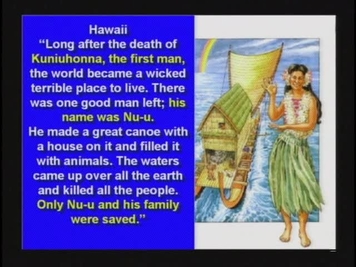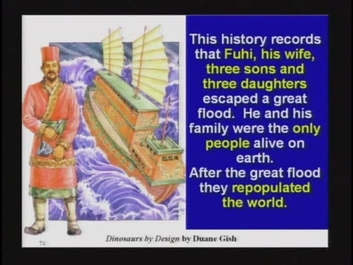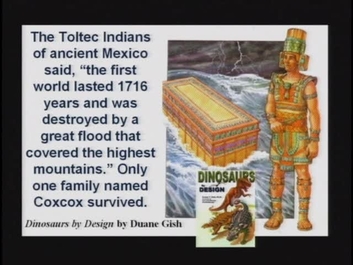 |
 |
 |
 |
 |
 |
 |
 |
|
 |
 |
 |
84 Reports of the flood
|
| Menu | back |
In older human cultures and on all five continents, historical traditions tell of a major flood event. Accordingly, geological strata all over the world indicate several continental flood catastrophes that can best be interpreted as post-flooding events following a single, gigantic, worldwide flood.
|
A diluvian flood is reported in seventy-seven different cultures spread over the entire globe, and the rescue came in the form of a ship in seventy-two of them. It would be surprising if such a catastrophe were not remembered in the historical traditions of the different peoples. Some circumstances that support these flood reports are:
Mass fossil graves:
Mass fossil graves of enormous extent are found on all continents of the Earth. For instance, the Old Red Sandstone in Scotland (160 km from the Orkneys) abounds with petrified fish that died a violent death. It is estimated that the Karroo formation (518,000km2, an area of extensive rock strata in South Africa) contains the skeletons of approximately 800 billion animals, mainly amphibians and reptiles (1).
Extensive coal strata:
The extent and distribution of coal deposits worldwide cannot be explained by slow processes. A peat layer approximately 50 m thick is required to form a coal seam one m thick. A coal seam 10 m thick would require collection of a layer of plant material about 500 m thick. These facts are most readily explained as the result of a gigantic flood catastrophe in which floating material drifted together and was then covered with sand and mud from the interior of the country (2). Since practically no roots had grown into the lower layers, the coal seams are evidence of a rapid deposition process.
Gigantic erosive floods:
Ice age cataclysmic floods, for example the Missoula floods in the north-western US, cut valleys hundreds of metres deep into hard rock. The geological debates lasted for decades until it finally became clear that these geographic findings could only be grasped in terms of a catastrophe (3). In Sciences March 29, 2002 edition, Victor R. Baker reported how many geologists had long ignored the effects of superfloods (4). It was generally assumed that the great majority of canyons and valleys had been formed by the gradual forces of wind and water over periods of thousands and millions of years. However, the new perceptions lead to a gradual rethinking (5).
Origins of the Grand Canyon:
Many geologists realize that the 28 km-long Grand Canyon could not possibly have been eroded by the Colorado River. It is easy to imagine a huge mass of water being dammed up behind the Kaibab Upwarp plateau towards the end of the post-flood events. Ice age rains may then have filled this lake to overflowing, whereupon the onrush of flood waters with their freight of rocks and boulders were able to carve out the gigantic valley of the Grand Canyon within a brief period (6).
Continent-wide sand distribution:
Much of the sand found today has been transported over great distances. Gravel and sand covering the Sahara over an area larger than 1,000 x 1,000 km was transported from the sea into the interior of the country and evenly distributed there (7). The silicate sands of Florida (USA) come from the Appalachians and were thus transported over a distance exceeding 700 km (8). The quartz gravel in North Dakota (USA) comes from the area around British Columbia (Canada) and must also have been transported farther than 700 km (9).
Noahs Ark:
|
 |
|
Of the seventy-two flood reports including a ship, the report of the biblical ark built by Noah is clearly the most sensible and logical:
The proportions of the biblical ark result in optimum floating stability, comparable to that of a modern container ship. The amount of material needed to construct the ark, with a width to height ratio of 0.5, is the lowest (10). The interior of the ark was sufficiently large enough to accommodate all animal species requiring protection from the flood, including food reserves sufficient to last for one year (11).
|
Continental drift (plate tectonics):
It can be assumed that all of the present-day continents were joined together immediately after the flood. Of the land animals that had survived in the ark, some spread rapidly throughout the continent and others found habitats in various regions therein. Rapid continental drift in the ensuing period put an end to this distribution process, so that marsupials, for example, are now found almost exclusively in Australia.
A gradual continental drift is still observed today, whereby it is quite conceivable that the rate at which this process takes place was much higher during the flood and in the postdiluvian centuries. Geophysicist John R. Baumgardner developed a computer simulation of the process modelled on such a scenario (12). To reach their present positions, Africa and America, for example, must have been moving apart at a rate of 12 cm/h during 500 years.
High-pressure minerals in subduction zones:
The rapid return of mineral types from subduction zones (tectonic plate submersion zones) demonstrates that rapid shifts in the Earths crust are still possible today. The presence of high-pressure minerals, e.g., in the Dora Maira massif in the western Alps, shows that such mineral types can rise to the surface quite rapidly. Geologists Frisch and Meschede describe,, This convoluted gliding and shifting process
can raise deep-lying mineral rapidly to near-surface strata. Destruction of these high-pressure minerals takes place when the rocks rise gradually or as a result of the influx of water during tectonic processes while they are rising. High-pressure minerals are only preserved if they rise rapidly and
are cooled quickly (13).
These 85 | Menu |
back
|
References:
|
| (1) |
David C.C. Watson, Weltschöpfung und Urgeschichte, pages 166167. |
| (2) |
Joachim Scheven, Karbonstudien, Neues Licht auf das Alter der Erde, Hänssler, 1986. |
| (3) |
Stephen. J. Gould, The Daumen des Panda, Suhrkamp, 2. Aufl., 2008., pages 204214. |
| (4) |
Victor R. Baker, Science 295, 29. März 2002, pages 23792380. |
| (5) |
Alexander and Edith Tollmann, Und die Sintflut gab es doch. Vom Mythos zur historischen Wahrheit, Droemer Knaur, München 1993. |
| (6) |
John D. Morris, Geology, Master Books, pages 69. (deutsche Fassung: factum August 2007 pages 2230). |
| (7) |
H. Füchtbauer and G. Müller, Sedimente und Sedimentgesteine II, 1977, 3. Auflage, Stuttgart. |
| (8) |
Carl R. Froede Jr., CRSQ 42, März 2006, page 229. |
| (9) |
Michael J. Oard, CRSQ 44, Frühling 2008, page 264. |
| (10) |
Werner Gitt, The sonderbarste Schiff der Weltgeschichte, Fundamentum 3/2000, pages 3681. |
| (11) |
Fred Hartmann und Reinhard Junker, Passten alle Tiere in die Arche Noah?, Wort and Wissen, Diskussionsbeitrag 4/90, http://www.wort-und-wissen.de/index2.php?artikel=disk/d90/4/d90-4m.html. |
| (12) |
John R. Baumgardner, Runaway subduction as the driving mechanism for the Genesis Flood, Proceedings of the Third International Conference on Creationism, 1994, Pittsburgh, Penn., USA, pages 6375. |
| (13) |
Wolfgang Frisch and Martin Meschede, Plattentektonik, Kontinentalverschiebung und Gebirgsbildung, 2007, Wissenschaftliche Buchgesellschaft, Darmstadt, pages 117118. | |
| |
| (Images) "Dinosaurs by Design" by Duane Gish |
| |
Comment this Site!
Freelance Minion wrote:
But doesn't the presence of all these other stories just prove Noah was ANOTHER allegory of a big local flood, or maybe prove it was the Chinese who saved the world by getting in a boat, and we are all descended from them?
The fact of mass fossil graves
|
 |
 |
 |
 |
|




